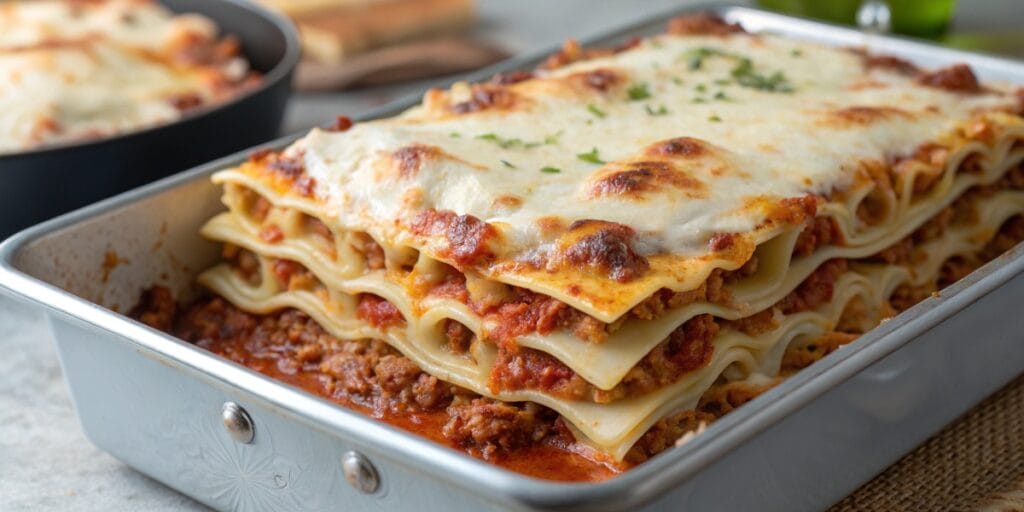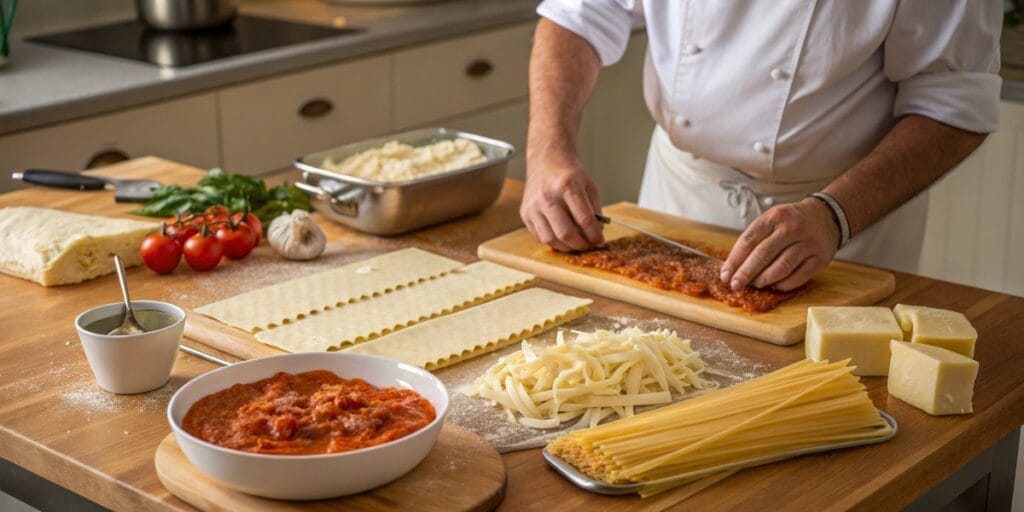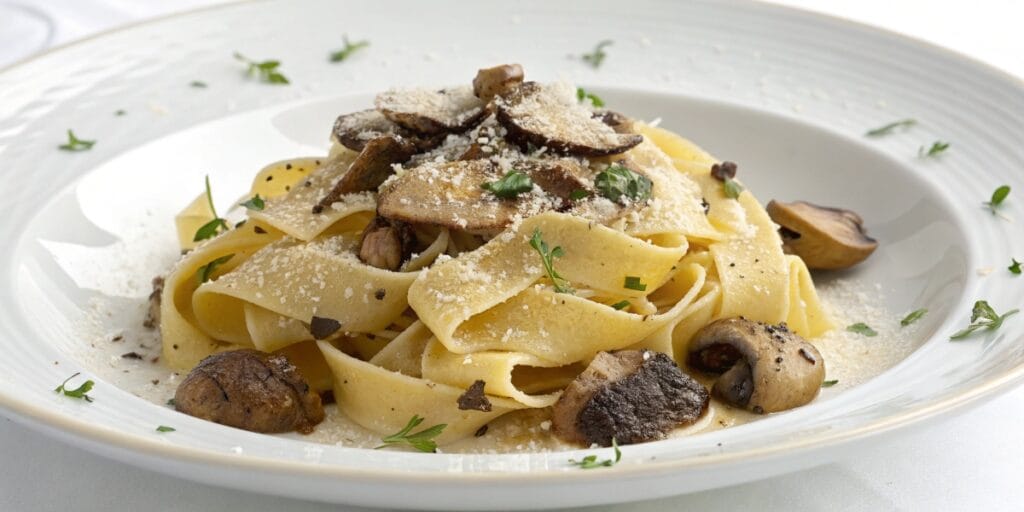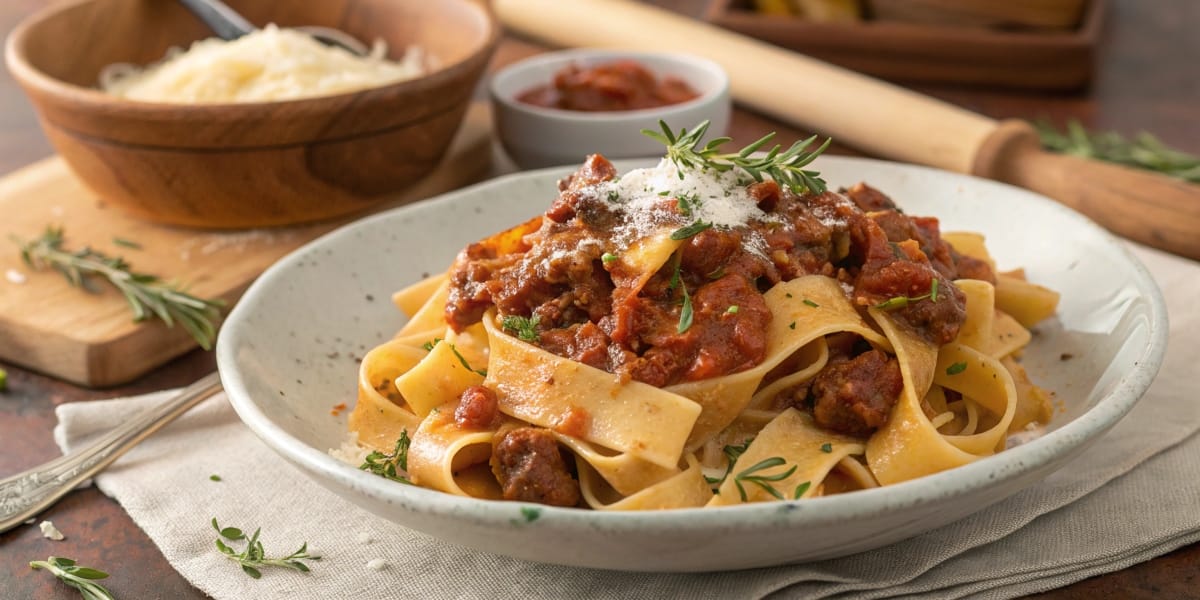What is the Difference Between Pappardelle and Lasagna Noodle?
When you think of Italian pasta, you might picture dishes full of rich, flavorful sauces and hearty ingredients. Among the various pasta shapes, pappardelle and lasagna noodles are two popular varieties, often used for completely different dishes. Though both are wide, flat types of pasta, their distinct shapes, textures, and culinary uses set them apart. This article will explore the key differences between pappardelle and lasagna noodles, focusing on their historical backgrounds, physical characteristics, and culinary applications, along with nutritional comparisons.
Introduction to Difference Between Pappardelle and Lasagna Noodles
Pappardelle and lasagna noodles are both essential in Italian cuisine, but their roles in cooking are distinct. Pappardelle is a thick, wide pasta, perfect for hearty meat sauces, while lasagna noodles are typically used in the creation of the layered, iconic dish lasagna. Understanding their differences will help you choose the right pasta for your next Italian meal.
What is Pappardelle?
Pappardelle is a broad, flat pasta, originating from the Tuscan region of Italy. This pasta is wider than most others, usually about 2 to 3 cm in width, giving it a substantial feel that holds up well under rich sauces like ragù. You can find pappardelle paired with various meats such as wild boar or beef, along with mushrooms and truffles in some recipes.
If you’re interested in exploring more about pappardelle’s rich history and culinary applications, you can check out this detailed guide on pasta shapes.
What is Lasagna Noodles?
they are another flat, wide pasta, but unlike pappardelle, they are designed specifically for layered dishes. These noodles are generally thinner and longer, with a shape that fits neatly into the baking dish used to assemble lasagna. The noodle layers are interspersed with meats, sauces, and cheeses to create a hearty, oven-baked dish.
In terms of historical significance, you can learn more about lasagna and other Italian culinary traditions through our post on regional Italian pasta dishes.

Historical Background
Both pappardelle and lasagna noodles have deep historical roots in Italian cuisine, with each pasta originating from a specific region and culture.
Origin of Pappardelle
The name pappardelle comes from the Italian verb “pappare,” which means “to gobble up” or “to devour.” This name reflects how hearty and satisfying the pasta is. Pappardelle hails from Tuscany, where it has been used in traditional dishes for centuries. The wide, thick nature of this pasta makes it perfect for pairing with rich, meaty sauces, especially those made from game meats like wild boar.
For more about Tuscany’s culinary contributions, visit our post on regional Tuscan cuisine.
Origin of Lasagna Noodles
Lasagna noodles have a history that dates back to ancient Rome. While the modern lasagna dish with its many layers evolved in Italy, ancient Romans used sheets of pasta in similar ways. Over time, these sheets became refined, leading to the modern-day lasagna noodles. The concept of layering pasta, sauce, and cheese to create a comforting casserole dish grew in popularity during the Middle Ages and remains a favorite in households today.
To dive deeper into the evolution of lasagna, check out our comprehensive guide on how lasagna evolved.
Physical Characteristics
While both pappardelle and lasagna noodles are wide, flat pasta types, their size, texture, and thickness vary significantly, affecting their use in the kitchen.
Size and Shape
- Pappardelle: Typically 2 to 3 cm wide, pappardelle is a thick, broad pasta. Its wide shape makes it ideal for hearty, chunky sauces. The thickness of the pasta allows it to hold up well under the weight of rich sauces.
- Lasagna Noodles: These noodles are longer than pappardelle, but they are thinner in comparison. Their size is designed to layer neatly in a baking dish. Lasagna noodles are often pre-cooked or oven-ready, making them easy to layer with fillings.
Texture and Thickness
- Pappardelle: The texture of pappardelle is dense and chewy, which allows it to absorb and complement the richness of the sauce. It is a pasta that pairs well with thick, meaty sauces, as the noodles have the strength to support the weight of the sauce.
- Lasagna Noodles: they are generally thinner and slightly more delicate than pappardelle. Their role is to provide structure in layered dishes, allowing the other ingredients to shine through.

Culinary Uses and Pairings
Each pasta has its own unique uses in the kitchen, and knowing how to pair them with the right sauces can elevate your dishes.
Traditional Dishes
- Pappardelle: This pasta is often paired with rich meat-based sauces like wild boar ragù or beef ragù. The wide, thick noodles work well with these heavier sauces, allowing the flavors to meld together. Pappardelle is also delicious when paired with earthy mushrooms or truffles for a vegetarian dish.
For recipes and ideas on how to prepare pappardelle, see our post on pasta sauces that pair perfectly.
- Lasagna Noodles: The traditional dish that uses lasagna noodles is, of course, lasagna. This dish involves layering the noodles with meats, sauces, and cheeses, then baking it all together. Lasagna noodles form the base structure of this iconic casserole, providing layers of texture between the fillings.
Learn how to make a classic lasagna from scratch in our detailed recipe guide for lasagna with Bolognese sauce.
Sauce Compatibility
- Pappardelle: The wide surface of pappardelle makes it an excellent choice for chunky, meaty sauces. It is a perfect match for rich ragùs, such as wild boar ragù, lamb, or beef.
- Lasagna Noodles: Lasagna noodles work best in a layered dish, where they are surrounded by rich sauces like béchamel or a meat sauce like Bolognese. The noodles don’t typically absorb the sauce, as they are meant to provide a structural foundation for the dish.
Nutritional Comparison Between Pappardelle and Lasagna Noodles?
Understanding the nutritional profiles of pappardelle and lasagna noodles can help you make informed decisions, especially when trying to balance your diet.
Caloric Content
- Pappardelle: One serving of pappardelle (about 1 cup) typically contains 220–250 calories, making it a calorie-dense option when paired with rich sauces.
- Lasagna Noodles: Lasagna noodles are slightly lower in calories than pappardelle on their own, but when used in a layered dish, the overall calorie count increases due to the addition of sauces, meats, and cheeses.
For a deeper dive into pasta and its nutritional value, explore our article on the health benefits of pasta.
Macronutrient Breakdown
- Pappardelle: A typical serving of pappardelle provides around 45–50 grams of carbohydrates and about 8–10 grams of protein. It is a hearty meal when paired with a protein-rich sauce.
- Lasagna Noodles: Lasagna noodles tend to be lower in protein than pappardelle but higher in carbohydrates. The nutritional profile can vary greatly depending on the fillings used in lasagna.
Dietary Considerations
Both pappardelle and lasagna noodles are typically made from durum wheat semolina and eggs, which means they are not suitable for those following gluten-free diets. There are, however, gluten-free alternatives available for both types of pasta.
Substituting Pappardelle for Lasagna Noodles
Feasibility
Difference Between Pappardelle and Lasagna Noodles
If you find yourself without lasagna noodles, you can use pappardelle as a substitute, but there are some adjustments to make. The wider, thicker nature of pappardelle may not stack as neatly in a lasagna dish, so it’s best to cut the noodles into smaller pieces if you’re attempting this substitution.
Preparation Adjustments
When using pappardelle in place of lasagna noodles, you’ll likely need to adjust the cooking time. Pappardelle generally cooks faster than traditional lasagna noodles, so ensure your dish is cooked thoroughly without overcooking the pasta.

Frequently Asked Questions about Difference Between Pappardelle and Lasagna Noodles?
Can I use pappardelle instead of lasagna noodles?
Yes, though pappardelle is thicker and wider, you can cut it into smaller pieces and use it in place of lasagna noodles. However, it may affect the overall texture and layering of the dish.
What is the best sauce for pappardelle?
Pappardelle pairs wonderfully with rich, meaty sauces, especially wild boar ragù or beef ragù. You can also serve it with earthy mushrooms and truffles for a vegetarian option.
Are lasagna noodles and pappardelle made from the same ingredients?
Both pastas are typically made from durum wheat semolina and eggs, but pappardelle is thicker and wider than lasagna noodles, which are designed for layering.
How do the cooking times compare between pappardelle and lasagna noodles?
Pappardelle cooks in about 2-3 minutes, while you need to cook lasagna noodle for a longer time, especially if they are not pre-cooked.
Can I make pappardelle at home?
Yes! Making pappardelle at home is relatively simple. You’ll need flour, eggs, and water to create the dough, then roll it out to your desired thickness before cutting it into strips.
Conclusion to Difference Between Pappardelle and Lasagna Noodles
In conclusion, pappardelle and lasagna noodles are both vital components of Italian cuisine, but they serve different purposes in cooking. Pappardelle pairs perfectly with hearty, meat-based sauces, while lasagna noodle hold layers together in dishes like lasagna. Understanding these differences helps you choose the right pasta for your dishes and culinary needs.

